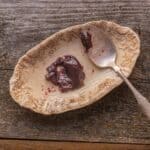Elderberry Jelly
Basic elderberry jelly. Yield: 2 cups
Servings: 8 Servings
Calories: 248kcal
Equipment
- 1 Pint mason jar
Ingredients
- 4 cups Elderberries
- ½ cup red wine vinegar
- 2 cup water
- 2 cup sugar
- 2 teaspoons apple pectin preferably Cuisine Tech brand
Instructions
- Cover the elderberries with the vinegar and water, then bring to a simmer and cook for 20 minutes on low heat.
- Drain the elderberries well and reserve the juice.
- Put a small stainless steel bowl or plate in the freezer to do set tests, and stainless steel is preferable as metal conducts differences in temperature faster than most other food-safe items.
- Mix the pectin and sugar.
- Bring the elderberry juice to a simmer, then add the sugar mixture and whisk to melt. Bring the mixture to a rolling boil, and cook until it starts to hover around 220F, skimming any foam that may rise to the top that can cloud the finished jelly. Once volume of the liquid in the pan starts to drop a bit, start doing set tests, continuing to let the syrup boil.
- To test the set, drop small ⅛ teaspoons or so of jelly on the frozen bowl, and when the liquid threatens to set and hold’s it’s shape, and doesn’t run like water immediately, pour into sterilized jars to seal, or process in a water bath.
- This is delicate work, and many of the commercially jellies I taste made from obscure fruit seem cooked down too far to me. The sweet spot for me is usually right after the jelly hits 220-225.
Notes
Other fruit juices like wild grape and chokecherry can be used the same way here.
Nutrition
Serving: 1tablespoon | Calories: 248kcal | Carbohydrates: 63g | Protein: 0.5g | Fat: 1g | Saturated Fat: 0.02g | Polyunsaturated Fat: 0.2g | Monounsaturated Fat: 0.1g | Sodium: 9mg | Potassium: 210mg | Fiber: 5g | Sugar: 15g | Vitamin A: 435IU | Vitamin C: 26mg | Calcium: 31mg | Iron: 1mg
